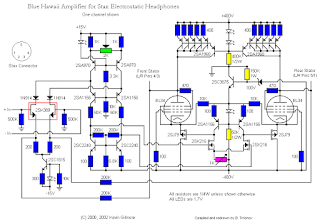I will explain here why i decided to make my own all tube design.
And why i did not used other designs.
First one explained, let´s start with "Blue Hawaii" (~4000$). This schematic is popular, and people like the sound. So it should be a perfect candidate to build ?


Big reason why i dislike this, are the strong global feedbacks ("masking distortion" was discussed in previous article).
Strong global feedbacks are unavoidable in DC coupled design, because you have to keep working points very stable. (or magic smoke may come out..) Second reason is the EL34´s, used here as rough CCS (wired as triodes). Their job is NOT to amplify signal, more or less, they are protecting from high voltage other components. Any change done to the signal by tubes, will be cancelled by global feedback...
Designer would do better job, if he replaced tubes with high voltage JFET´s or Depletion MOSFET´s. (IXYS)
Not saying the amplifier is bad, but tubes here are useless. Fishy or funny thing, is schematic edit in the picture to be seen. Maybe somebody just taking steps to protect his design...
Second example is the STAX SRM T1. Here situation is better (tubes are driven directly-they do the signal amplification), but again DC coupled stages and global feedback is minimizing tube sound character. Situation is similar like first example.
If designer AC coupled the headphones, used CCS instead anode resistors, and made tube endstages working more independly..
Designers have problems sourcing hi-voltage small power transistors. Those were made for CRT TV (are good also for Stax amps). Since CRT TV are gone, these transistors are not in production. I understand this problem, but see no reason to use tubes in crippled way.
I am interested on tube equipment about his sound profile, amplifying characteristics. It makes no sense to me, to build a hybrid amplifier, where any changes to sound would be erased by transistor global feedbacks. Just a waste to use tubes there. Thankfully still some hybrid designs exists, where tube character is amplified (and preserved) by transistors.

Žiadne komentáre:
Zverejnenie komentára